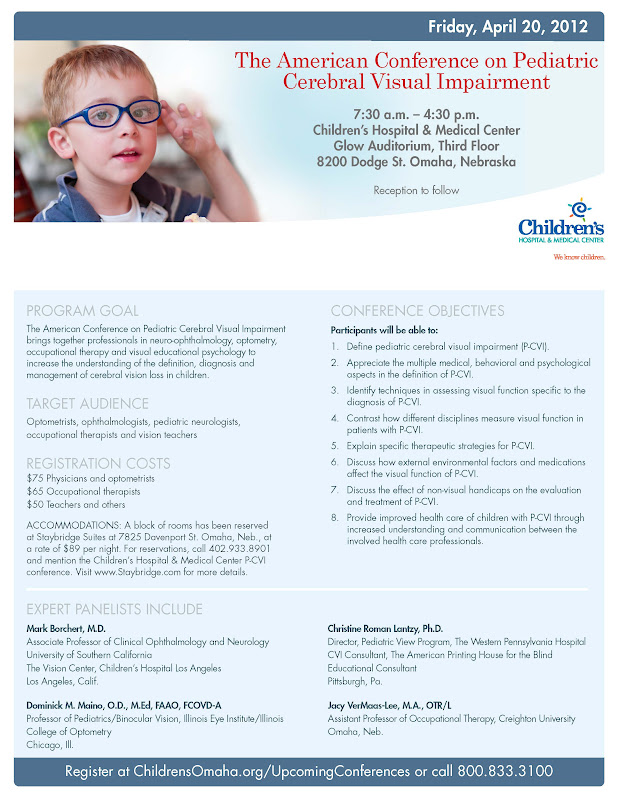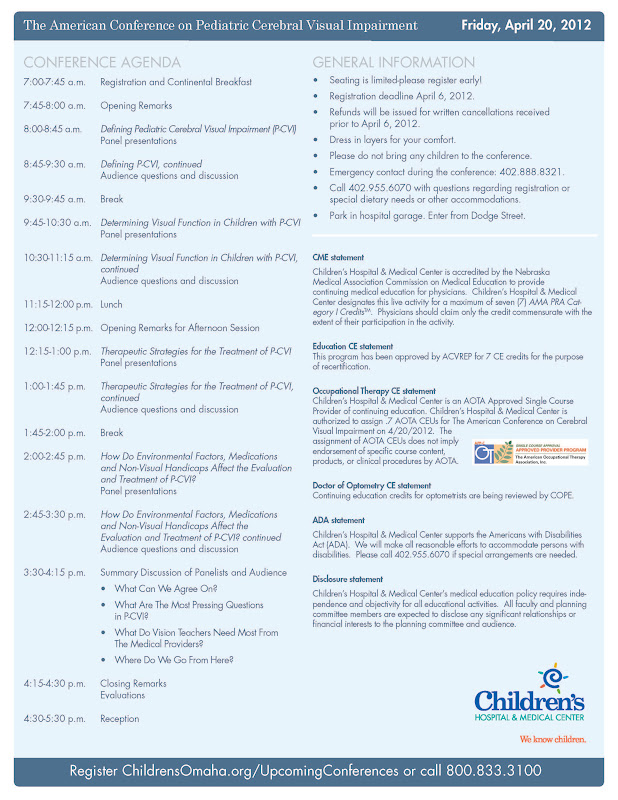MainosMemos contains the latest research and information about eye and vision care of children, developmental disabilities, Traumatic/Acquired Brain Injury and other topics of interest to me (and hopefully you!).
Saturday, February 11, 2012
Friday, February 10, 2012
Will You Boycott Elsevier?
An article in The Chronicle of Higher Education noted that: .....According to the boycotters, Elsevier, which publishes over 2,000 journals including the prestigious Cell and The Lancet,
is abusing academic researchers in three areas. First there are the
prices. Then the company bundles subscriptions to lesser journals
together with valuable ones, forcing libraries to spend money to buy
things they don't want in order to get a few things they do want. And,
most recently, Elsevier has supported a proposed federal law, the
Research Works Act (HR 3699), that could prevent agencies like the National Institutes of Health from making all articles written by grant recipients freely available.....
Will you boycott Elsevier? Tell them how you feel. DM
Will you boycott Elsevier? Tell them how you feel. DM
Thursday, February 9, 2012
Neurocognitive mechanisms of gaze-expression interactions in face processing and social attention.
Neurocognitive mechanisms of gaze-expression interactions in face processing and social attention.
....The face conveys a rich source of non-verbal information used during social communication. ....Here we review recent behavioral and neuroscientific evidence suggesting that within the dynamic stream, concurrent changes in eye gaze and emotional expression can yield early independent effects on face judgments and covert shifts of visuospatial attention.....
Wednesday, February 8, 2012
Call for Papers & Posters for COVD 42nd Annual Meeting
Call for Papers & Posters for COVD 42nd Annual Meeting
COVD is soliciting abstracts for papers and posters to be presented at the COVD 42nd Annual Meeting in Ft. Worth, Texas. Any person wishing to make a presentation is invited to submit a proposal as outlined below.
All abstracts will be reviewed by the Research Committee and will be judged on the basis of overall quality, completion of required information, relevance to behavioral and functional vision, subject matter, innovation, and attention to key questions in the field. Proposals may include research results, case studies, or new and innovative diagnostic procedures or treatment techniques.
Download the application
Deadline for submission of abstracts is June 11, 2012
Tuesday, February 7, 2012
Visual perceptual strengths and weaknesses in adults with intellectual disabilities compared with a birth year-matched norm.
Visual perceptual strengths and weaknesses in adults with intellectual disabilities compared with a birth year-matched no
.... The ventral and dorsal streams are considered to be the brain substrates of vision for perception and action, respectively. Using the Developmental Test of Visual Perception (DTVP), the current study examined whether visual perceptual strengths and weaknesses in adults with intellectual disabilities (ID) were attributable to the dichotomy of the visual streams. .... Visual perceptual strengths and weaknesses in persons with ID were difficult to explain on the basis of two visual streams. An interpretation originating in a different research context (e.g. frontal-lobe dysfunction) appears to be required for explaining visual perceptual weaknesses in persons with ID. For persons with DS, strong frontal-lobe dysfunction with atypical lateralisation might be the pathological determinant of visual perceptual weaknesses....
Virtual Reality Anatomy: Is It Comparable with Traditional Methods in the Teaching of Human Forearm Musculoskeletal Anatomy?
Virtual Reality Anatomy: Is It Comparable with Traditional Methods in the Teaching of Human Forearm Musculoskeletal Anatomy?
The use of cadavers to teach anatomy is well established, but limitations with this approach have led to the introduction of alternative teaching methods. One such method is the use of three-dimensional virtual reality computer models. ....... The groups were assessed on anatomy of the forearm by a ten question practical examination. ANOVA analysis showed the model group mean test score to be significantly higher than the control group ..... and not significantly different to the traditional methods group ..... Feedback from all users of the e-resource was positive. Virtual reality anatomy learning can be used to compliment traditional teaching methods effectively.....
Monday, February 6, 2012
Migraine and stroke: a complex association with clinical implications
Migraine and stroke: a complex association with clinical implications
Migraine
and stroke are two common and heterogeneous neurovascular disorders
with complex relations. ....but a
doubling of the risk of ischaemic stroke in people who have migraine
with aura. ....... Whether
the increased risk of ischaemic stroke applies to migraine with aura as a
primary headache disorder or is partly due to migraine with aura
secondary to other disorders remains to be elucidated....
2012 Robert Wold Southern California Behavioral Vision Seminar
The Behavioral Vision Seminar will be held on March 11-12, 2012 at the Crowne Plaza Hotel (Mission Valley) in San Diego.This year's speakers will be Ken Ciuffreda O.D., PhD. and Diana Eastman-Ludlum.
For a Program and Registration form please email Donald J. Janiuk, O.D., FCOVD at [email protected]
American Conference on Pediatric Cerebral Visual Impairment
Registration is now open for
The American
Conference on Pediatric Cerebral Visual Impairment.
This conference will
take place on Friday, April 20th at the Children's Hospital and Medical
Center in Omaha, Nebraska. The conference brochure and registration
webpage can be found at www.childrensomaha.org/upcomingconferences.
We are honored to have the following panel of
experts: Mark Borchert, MD, Dominick Maino, OD, MEd, FAAO, FCOVD-A, Christine Roman Lantzy, PhD and Jacy VerMaas-Lee, MA, OTR/L.
The thesis of the conference is to bring together
experts from ophthalmology, optometry, occupational therapy and vision education
to discuss the definition, diagnosis, assessment of visual
function, treatment and management of pediatric CVI. What makes this
conference unique is the multidisciplinary format in which each expert will
address each of four topics concerning CVI There will be a discussion
session to include questions from the audience after each topic is
covered. All professionals from each of the four disciplines represented
will be in the same lecture room at the same time.
The goals of the conference are two.
First, to increase understanding of pediatric CVI. Second, and just
as important, is to improve interdisciplinary understanding regarding what each
of our disciplines is trying to accomplish for these children. Most of
these patients have an ophthalmologist, a therapeutic optometrist, an
occupational therapist and a vision teacher. By understanding each others
approach to these patients, and being able to communicate more effectively with
each other, the level of care provided to these children should be
elevated.
Ophthalmologists, optometrists, occupational
therapists, physical therapists, speech and language therapists, teachers, orthoptists, technicians and nurses are all invited
to attend.
Sunday, February 5, 2012
Watch for.....
...in the new book from Lippincott...
Visual Diagnosis and
Care
of the Patient with
Special Needs
Edited by:
Marc B. Taub, OD, MS, FAAO, FCOVD,
Mary Bartuccio, OD,
FAAO, FCOVD,
Dominick M. Maino,
OD, MEd, FAAO, FCOVD-A
Available from Amazon for pre-order....
Child Vision Research Society
My colleague, Dr. Susan Leat, recently sent me this email about the Child
Vision Research Society conference. Please read. Send in an abstract. Tell your friends....
I am writing to let you know about the Child Vision
Research Society 2013, in case you might not be aware of it. The Child
Vision Research Society (CVRS) comprises researchers from many different
countries interested in the development
of vision in infancy and childhood under normal and abnormal
conditions. A wide range of disciplines, including anatomy, physiology,
neurology, psychology, ophthalmology and rehabilitation are represented
in the CVRS. The CVRS holds a conference every 2 years,
to provide an opportunity for exchanging new ideas and findings between
basic scientists and clinicians concerned with vision in infants and
children. This conference has always been held in Europe until now. But
we are pleased and excited to have been chosen
to hold it in Canada-the first time in North America and this will be in
June 2013. We are therefore hoping to bring together researchers in
this field from Europe and North America. I, together with Carol
Westall, am organizing it and it will be held both in the School of
Optometry and Vision Science, Waterloo and the Hospital
for Sick Children, Toronto.
So I am contacting you to invite you personally to submit (when the call for abstracts comes out) and attend.
You can see more details at
http://www.cvrsoc.org/ and you can also join the mailing list (http://www.cvrsoc.org/?page_id=17) , if you are not already on it, so that you receive the updates when they are sent out (we don’t send large
numbers of mailings, just in case you are worried about numerous e mails).
If you know of others who might be interested, please feel free to forward the message.
Regards,
Sue Leat
Susan Jennifer Leat, BSc, PhD, FCOptom, FAAO
Professor
Head of Residencies
http://www.optometry.uwaterloo.ca/people/leat/
Professor
Head of Residencies
http://www.optometry.uwaterloo.ca/people/leat/
Subscribe to:
Posts (Atom)


